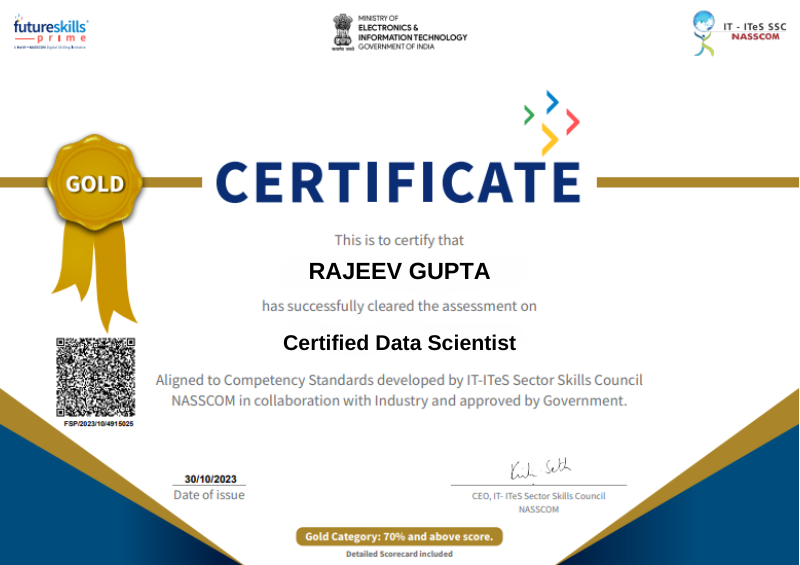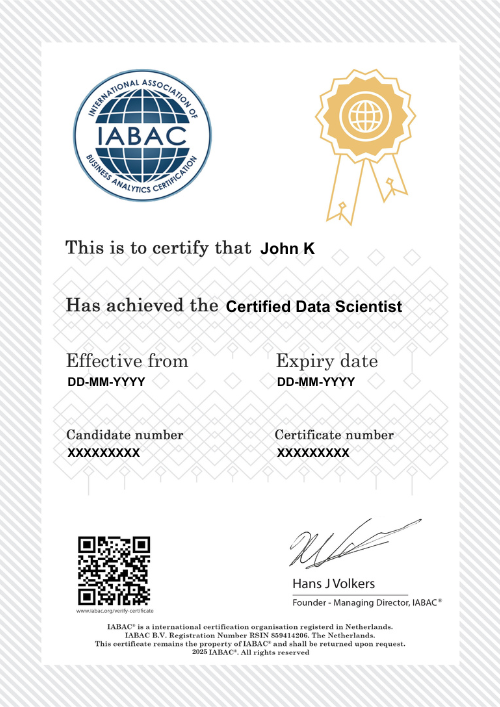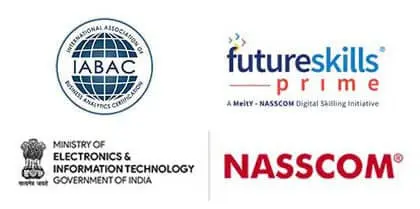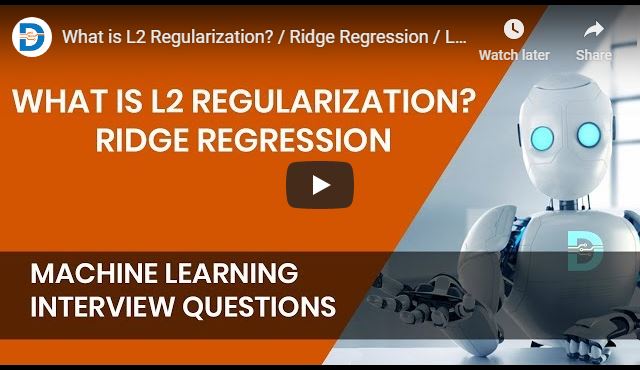Instructor Led Live Online
Self Learning + Live Mentoring
In - Person Classroom Training





MODULE 1: DATA SCIENCE ESSENTIALS
• Introduction to Data Science
• Evolution of Data Science
• Big Data Vs Data Science
• Data Science Terminologies
• Data Science vs AI/Machine Learning
• Data Science vs Analytics
MODULE 2: DATA SCIENCE DEMO
• Business Requirement: Use Case
• Data Preparation
• Machine learning Model building
• Prediction with ML model
• Delivering Business Value.
MODULE 3: ANALYTICS CLASSIFICATION
• Types of Analytics
• Descriptive Analytics
• Diagnostic Analytics
• Predictive Analytics
• Prescriptive Analytics
• EDA and insight gathering demo in Tableau
MODULE 4: DATA SCIENCE AND RELATED FIELDS
• Introduction to AI
• Introduction to Computer Vision
• Introduction to Natural Language Processing
• Introduction to Reinforcement Learning
• Introduction to GAN
• Introduction to Generative Passive Models
MODULE 5: DATA SCIENCE ROLES & WORKFLOW
• Data Science Project workflow
• Roles: Data Engineer, Data Scientist, ML Engineer and MLOps Engineer
• Data Science Project stages.
MODULE 6: MACHINE LEARNING INTRODUCTION
• What Is ML? ML Vs AI
• ML Workflow, Popular ML Algorithms
• Clustering, Classification And Regression
• Supervised Vs Unsupervised
MODULE 7: DATA SCIENCE INDUSTRY APPLICATIONS
• Data Science in Finance and Banking
• Data Science in Retail
• Data Science in Health Care
• Data Science in Logistics and Supply Chain
• Data Science in Technology Industry
• Data Science in Manufacturing
• Data Science in Agriculture
MODULE 1: PYTHON BASICS
• Introduction of python
• Installation of Python and IDE
• Python Variables
• Python basic data types
• Number & Booleans, strings
• Arithmetic Operators
• Comparison Operators
• Assignment Operators
MODULE 2: PYTHON CONTROL STATEMENTS
• IF Conditional statement
• IF-ELSE
• NESTED IF
• Python Loops basics
• WHILE Statement
• FOR statements
• BREAK and CONTINUE statements
MODULE 3: PYTHON DATA STRUCTURES
• Basic data structure in python
• Basics of List
• List: Object, methods
• Tuple: Object, methods
• Sets: Object, methods
• Dictionary: Object, methods
MODULE 4: PYTHON FUNCTIONS
• Functions basics
• Function Parameter passing
• Lambda functions
• Map, reduce, filter functions
MODULE 1: OVERVIEW OF STATISTICS
• Introduction to Statistics
• Descriptive And Inferential Statistics
• Basic Terms Of Statistics
• Types Of Data
MODULE 2: HARNESSING DATA
• Random Sampling
• Sampling With Replacement And Without Replacement
• Cochran's Minimum Sample Size
• Types of Sampling
• Simple Random Sampling
• Stratified Random Sampling
• Cluster Random Sampling
• Systematic Random Sampling
• Multi stage Sampling
• Sampling Error
• Methods Of Collecting Data
MODULE 3: EXPLORATORY DATA ANALYSIS
• Exploratory Data Analysis Introduction
• Measures Of Central Tendencies: Mean,Median And Mode
• Measures Of Central Tendencies: Range, Variance And Standard Deviation
• Data Distribution Plot: Histogram
• Normal Distribution & Properties
• Z Value / Standard Value
• Empirical Rule and Outliers
• Central Limit Theorem
• Normality Testing
• Skewness & Kurtosis
• Measures Of Distance: Euclidean, Manhattan And Minkowski Distance
• Covariance & Correlation
MODULE 4: HYPOTHESIS TESTING
• Hypothesis Testing Introduction
• P- Value, Critical Region
• Types of Hypothesis Testing
• Hypothesis Testing Errors : Type I And Type II
• Two Sample Independent T-test
• Two Sample Relation T-test
• One Way Anova Test
• Application of Hypothesis testing
MODULE 1: MACHINE LEARNING INTRODUCTION
• What Is ML? ML Vs AI
• Clustering, Classification And Regression
• Supervised Vs Unsupervised
MODULE 2: PYTHON NUMPY PACKAGE
• Introduction to Numpy Package
• Array as Data Structure
• Core Numpy functions
• Matrix Operations, Broadcasting in Arrays
MODULE 3: PYTHON PANDAS PACKAGE
• Introduction to Pandas package
• Series in Pandas
• Data Frame in Pandas
• File Reading in Pandas
• Data munging with Pandas
MODULE 4: VISUALIZATION WITH PYTHON - Matplotlib
• Visualization Packages (Matplotlib)
• Components Of A Plot, Sub-Plots
• Basic Plots: Line, Bar, Pie, Scatter
MODULE 5: PYTHON VISUALIZATION PACKAGE - SEABORN
• Seaborn: Basic Plot
• Advanced Python Data Visualizations
MODULE 6: ML ALGO: LINEAR REGRESSSION
• Introduction to Linear Regression
• How it works: Regression and Best Fit Line
• Modeling and Evaluation in Python
MODULE 7: ML ALGO: LOGISTIC REGRESSION
• Introduction to Logistic Regression
• How it works: Classification & Sigmoid Curve
• Modeling and Evaluation in Python
MODULE 8: ML ALGO: K MEANS CLUSTERING
• Understanding Clustering (Unsupervised)
• K Means Algorithm
• How it works : K Means theory
• Modeling in Python
MODULE 9: ML ALGO: KNN
• Introduction to KNN
• How It Works: Nearest Neighbor Concept
• Modeling and Evaluation in Python
MODULE 1: FEATURE ENGINEERING
• Introduction to Feature Engineering
• Feature Engineering Techniques: Encoding, Scaling, Data Transformation
• Handling Missing values, handling outliers
• Creation of Pipeline
• Use case for feature engineering
MODULE 2: ML ALGO: SUPPORT VECTOR MACHINE (SVM)
• Introduction to SVM
• How It Works: SVM Concept, Kernel Trick
• Modeling and Evaluation of SVM in Python
MODULE 3: PRINCIPAL COMPONENT ANALYSIS (PCA)
• Building Blocks Of PCA
• How it works: Finding Principal Components
• Modeling PCA in Python
MODULE 4: ML ALGO: DECISION TREE
• Introduction to Decision Tree & Random Forest
• How it works
• Modeling and Evaluation in Python
MODULE 5: ENSEMBLE TECHNIQUES - BAGGING
• Introduction to Ensemble technique
• Bagging and How it works
• Modeling and Evaluation in Python
MODULE 6: ML ALGO: NAÏVE BAYES
• Introduction to Naive Bayes
• How it works: Bayes' Theorem
• Naive Bayes For Text Classification
• Modeling and Evaluation in Python
MODULE 7: GRADIENT BOOSTING, XGBOOST
• Introduction to Boosting and XGBoost
• How it works?
• Modeling and Evaluation of in Python
MODULE 1: TIME SERIES FORECASTING - ARIMA
• What is Time Series?
• Trend, Seasonality, cyclical and random
• Stationarity of Time Series
• Autoregressive Model (AR)
• Moving Average Model (MA)
• ARIMA Model
• Autocorrelation and AIC
• Time Series Analysis in Python
MODULE 2: SENTIMENT ANALYSIS
• Introduction to Sentiment Analysis
• NLTK Package
• Case study: Sentiment Analysis on Movie Reviews
MODULE 3: REGULAR EXPRESSIONS WITH PYTHON
• Regex Introduction
• Regex codes
• Text extraction with Python Regex
MODULE 4: ML MODEL DEPLOYMENT WITH FLASK
• Introduction to Flask
• URL and App routing
• Flask application – ML Model deployment
MODULE 5: ADVANCED DATA ANALYSIS WITH MS EXCEL
• MS Excel core Functions
• Advanced Functions (VLOOKUP, INDIRECT..)
• Linear Regression with EXCEL
• Data Table
• Goal Seek Analysis
• Pivot Table
• Solving Data Equation with EXCEL
MODULE 6: AWS CLOUD FOR DATA SCIENCE
• Introduction of cloud
• Difference between GCC, Azure, AWS
• AWS Service ( EC2 instance)
MODULE 7: AZURE FOR DATA SCIENCE
• Introduction to AZURE ML studio
• Data Pipeline
• ML modeling with Azure
MODULE 8: INTRODUCTION TO DEEP LEARNING
• Introduction to Artificial Neural Network, Architecture
• Artificial Neural Network in Python
• Introduction to Convolutional Neural Network, Architecture
• Convolutional Neural Network in Python
MODULE 1: DATABASE INTRODUCTION
• DATABASE Overview
• Key concepts of database management
• Relational Database Management System
• CRUD operations
MODULE 2: SQL BASICS
• Introduction to Databases
• Introduction to SQL
• SQL Commands
• MY SQL workbench installation
MODULE 3: DATA TYPES AND CONSTRAINTS
• Numeric, Character, date time data type
• Primary key, Foreign key, Not null
• Unique, Check, default, Auto increment
MODULE 4: DATABASES AND TABLES (MySQL)
• Create database
• Delete database
• Show and use databases
• Create table, Rename table
• Delete table, Delete table records
• Create new table from existing data types
• Insert into, Update records
• Alter table
MODULE 5: SQL JOINS
• Inner Join, Outer Join
• Left Join, Right Join
• Self Join, Cross join
• Windows function: Over, Partition, Rank
MODULE 6: SQL COMMANDS AND CLAUSES
• Select, Select distinct
• Aliases, Where clause
• Relational operators, Logical
• Between, Order by, In
• Like, Limit, null/not null, group by
• Having, Sub queries
MODULE 7 : DOCUMENT DB/NO-SQL DB
• Introduction of Document DB
• Document DB vs SQL DB
• Popular Document DBs
• MongoDB basics
• Data format and Key methods
MODULE 1: GIT INTRODUCTION
• Purpose of Version Control
• Popular Version control tools
• Git Distribution Version Control
• Terminologies
• Git Workflow
• Git Architecture
MODULE 2: GIT REPOSITORY and GitHub
• Git Repo Introduction
• Create New Repo with Init command
• Git Essentials: Copy & User Setup
• Mastering Git and GitHub
MODULE 3: COMMITS, PULL, FETCH AND PUSH
• Code Commits
• Pull, Fetch and Conflicts resolution
• Pushing to Remote Repo
MODULE 4: TAGGING, BRANCHING AND MERGING
• Organize code with branches
• Checkout branch
• Merge branches
• Editing Commits
• Commit command Amend flag
• Git reset and revert
MODULE 5: GIT WITH GITHUB AND BITBUCKET
• Creating GitHub Account
• Local and Remote Repo
• Collaborating with other developers
MODULE 1: BIG DATA INTRODUCTION
• Big Data Overview
• Five Vs of Big Data
• What is Big Data and Hadoop
• Introduction to Hadoop
• Components of Hadoop Ecosystem
• Big Data Analytics Introduction
MODULE 2 : HDFS AND MAP REDUCE
• HDFS – Big Data Storage
• Distributed Processing with Map Reduce
• Mapping and reducing stages concepts
• Key Terms: Output Format, Partitioners,
• Combiners, Shuffle, and Sort
MODULE 3: PYSPARK FOUNDATION
• PySpark Introduction
• Spark Configuration
• Resilient distributed datasets (RDD)
• Working with RDDs in PySpark
• Aggregating Data with Pair RDDs
MODULE 4: SPARK SQL and HADOOP HIVE
• Introducing Spark SQL
• Spark SQL vs Hadoop Hive
MODULE 1: TABLEAU FUNDAMENTALS
• Introduction to Business Intelligence & Introduction to Tableau
• Interface Tour, Data visualization: Pie chart, Column chart, Bar chart.
• Bar chart, Tree Map, Line Chart
• Area chart, Combination Charts, Map
• Dashboards creation, Quick Filters
• Create Table Calculations
• Create Calculated Fields
• Create Custom Hierarchies
MODULE 2: POWER-BI BASICS
• Power BI Introduction
• Basics Visualizations
• Dashboard Creation
• Basic Data Cleaning
• Basic DAX FUNCTION
MODULE 3 : DATA TRANSFORMATION TECHNIQUES
• Exploring Query Editor
• Data Cleansing and Manipulation:
• Creating Our Initial Project File
• Connecting to Our Data Source
• Editing Rows
• Changing Data Types
• Replacing Values
MODULE 4: CONNECTING TO VARIOUS DATA SOURCES
• Connecting to a CSV File
• Connecting to a Webpage
• Extracting Characters
• Splitting and Merging Columns
• Creating Conditional Columns
• Creating Columns from Examples
• Create Data Model
There are no strict eligibility criteria for a career in data science, making it accessible to individuals from various educational backgrounds. However, a strong foundation in mathematics, statistics, and programming can be beneficial. Gaining relevant skills through courses or hands-on projects is essential for success in the field.
The duration of a data science course in Shimla typically ranges from 4 to 12 months. This time frame depends on the chosen learning mode and specific courses available. For exact details, it’s best to consult with the training provider.
The average entry-level salary for data scientists in Shimla varies, but it typically ranges between INR 3.5 to INR 6 lakh per annum. Factors like the candidate’s skills, qualifications, and the hiring organization can influence this.
Data science professionals in Shimla can expect a growing demand for their skills as more organizations embrace data-driven decision-making. With technology advancements and AI adoption, the demand for data scientists is set to rise steadily across industries.
When looking for data science courses in Shimla, it's important to check for internships and job placements, as these are crucial for a successful career in data science. DataMites Institute is highly regarded for its data science course, offering internationally recognized certifications along with practical training. With over 10 years of experience in the field, we provide valuable opportunities for internships and job placements.
There is no necessary programming knowledge required to start learning data science individuals can develop these skills based on their interest. If needed, they can learn programming languages like Python or R to enhance their understanding of data manipulation and analysis. Ultimately, strong analytical skills and domain knowledge are also essential for success in the field.
Individuals without an engineering background can transition into data science, especially with a strong grasp of statistics, problem-solving, and programming skills. Many successful data scientists come from diverse academic fields such as economics, physics, and social sciences.
A data science course teaches core concepts like data analysis, machine learning, and statistical modeling. Students also learn tools such as Python, R, and SQL and how to apply them in real-world scenarios to derive insights from data.
A data scientist is a professional skilled in analyzing and interpreting complex data to help organizations make informed decisions. They often build predictive models, analyze trends, and collaborate with business teams to solve data-driven problems.
The most effective way to learn data science in Shimla is through structured courses, practical projects, and continuous practice. Online courses combined with mentorship or local workshops can also provide a well-rounded learning experience.
There are no strict core competencies required to learn data science, but the skills involved are relatively easy to grasp. Key skills include analytical thinking, basic programming knowledge in languages like Python or R, and a foundational understanding of statistics.
Yes, data science roles are in high demand globally, and this trend is expected to continue. The growing reliance on big data, AI, and predictive analytics is driving the need for skilled data professionals across industries.
Yes, it is possible to pursue data science without a B.Tech. degree. Many professionals from different academic backgrounds, including economics, statistics, and business, successfully enter the field through specialized courses and certifications.
Yes, Python is widely regarded as the primary programming language for data science due to its ease of use, versatility, and extensive library support for data analysis, machine learning, and visualization tasks.
The most frequently used libraries in data science projects include Pandas and NumPy for data manipulation, Scikit-learn for machine learning, Matplotlib and Seaborn for visualization, and TensorFlow and Keras for deep learning.
Taking a data science course can significantly enhance career prospects by providing essential skills and knowledge needed for roles in analytics, machine learning, and AI. It also demonstrates a commitment to continuous learning in a fast-evolving field.
Yes, focusing on learning Python is highly recommended for anyone pursuing data science, as it is the most widely used language in the field. Python’s extensive libraries and ease of use make it essential for data analysis, machine learning, and automation.
Data science can be challenging due to its interdisciplinary nature, requiring knowledge in mathematics, programming, and domain-specific expertise. However, with dedication, hands-on practice, and a structured learning approach, it is an achievable field to master.
The rise of artificial intelligence complements rather than threatens data science careers. AI and data science are interlinked, with AI often relying on data science techniques to train models, making data professionals even more valuable in the tech landscape.
MATLAB is a useful tool for certain data science applications, particularly in academic and engineering domains. However, Python and R are more popular choices due to their open-source nature and broad adoption in the data science community.
To enroll in the DataMites Data Science course, please visit our official website. Select your desired course, complete the registration form, and proceed with the payment. You will receive an email confirmation once your enrollment is successful.
DataMites offers a robust Data Science course that includes 25 Capstone projects and 1 Client project. These projects are designed to provide students with hands-on experience, allowing them to apply their theoretical knowledge in real-world scenarios. This practical approach enhances learning outcomes and prepares students for industry challenges.
Upon enrolling in the Data Science course in Shimla, you will receive comprehensive course materials, including textbooks, digital resources, and access to online learning platforms. Additionally, you will have access to project-based assignments and real-world case studies to enhance your learning experience. Our goal is to provide you with all the necessary tools to succeed in your data science journey.
Upon successfully completing the DataMites Data Scientist course in Shimla, participants receive certifications from IABAC® and NASSCOM® FutureSkills Certification, which are globally recognized. These certifications validate your expertise in data science and significantly enhance your career opportunities. Additionally, you will receive completion certificates for the various modules and projects undertaken during the course.
Yes, DataMites offers a comprehensive Data Science course in Shimla that includes placement support. Our dedicated team assists students in job placement through workshops, resume preparation, and interview coaching. Enroll now to enhance your career opportunities in the data science field.
Yes, the Data Science course at DataMites in Shimla includes an internship component. This provides students with practical experience, allowing them to apply their skills in real-world projects. Internships are a valuable part of the learning process at DataMites.
The fee for the DataMites Data Science course in Shimla ranges from INR 30,000 to INR 80,000, depending on the selected learning mode and specific courses. For more detailed information on the fee structure, please contact our admissions team. We aim to provide affordable and accessible education for all our students.
DataMites employs experienced instructors for the Data Science course, each with extensive industry knowledge and practical expertise. Ashok Veda, the lead mentor and CEO at Rubixe, plays a key role in guiding our students. Our faculty members are dedicated to providing high-quality education and hands-on training, ensuring a comprehensive learning experience to equip students with the skills needed for success in the field.
Yes, DataMites offers the opportunity to attend a demo class for the Data Science course in Shimla. This allows prospective students to experience the course structure and teaching methods before making a decision.
Yes, if you miss a class, DataMites provides options for you to make it up. You can attend a recorded session or join a different class within the Flexi-Pass validity period.
If you cancel your enrollment, you may be eligible for a refund based on our refund policy. Please refer to the specific terms outlined during your registration for detailed information on eligibility and the refund process.
The Flexi-Pass offered by DataMites provides students with the flexibility to attend multiple training sessions within a duration of 3 months. This option allows learners to select sessions that align with their schedule and learning preferences. It is designed to enhance the learning experience by offering adaptability and convenience.
Yes, DataMites offers flexible EMI options for the Data Science course in Shimla. You can utilize various payment methods, including credit cards, debit cards, net banking, or other online payment options. For further information, please reach out to our admissions team.
The Data Science syllabus at DataMites includes essential topics such as data analysis, machine learning, statistical modeling, and data visualization. Participants will also engage in hands-on projects, including 25 Capstone projects and 1 Client project, to reinforce their learning. Our comprehensive curriculum is designed to equip students with the skills needed for a successful career in data science.
To enroll in the Certified Data Scientist course, visit our website and select the course. Complete the registration form and make the payment. You will receive a confirmation email with all the necessary details.
The DataMites Placement Assistance Team(PAT) facilitates the aspirants in taking all the necessary steps in starting their career in Data Science. Some of the services provided by PAT are: -
The DataMites Placement Assistance Team(PAT) conducts sessions on career mentoring for the aspirants with a view of helping them realize the purpose they have to serve when they step into the corporate world. The students are guided by industry experts about the various possibilities in the Data Science career, this will help the aspirants to draw a clear picture of the career options available. Also, they will be made knowledgeable about the various obstacles they are likely to face as a fresher in the field, and how they can tackle.
No, PAT does not promise a job, but it helps the aspirants to build the required potential needed in landing a career. The aspirants can capitalize on the acquired skills, in the long run, to a successful career in Data Science.









